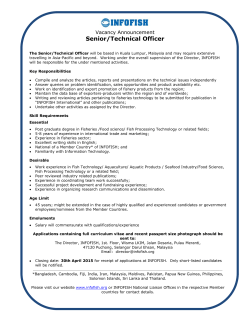
Fishing in Arctic Waters
Fishing in Arctic Waters Brian R. MacKenzie CMEC DTU Aqua Charlottenlund, Denmark © Globec Center for Macroecology, Evolution and Climate National Institute for Aquatic Resources (DTU Aqua) Technical University of Denmark Arctic Sea Ice is Melting 1991 Median 1979-2000 2010 UNEP 2012 Oceans are Becoming More Acidic UNEP 2012 pH is falling… Climate Change Impacts on Fish Populations Climate change is expected to have significant direct and indirect impacts on fish populations at various stages in their life histories, including: -distribution and migration (timing, location, duration) -stock size/abundance -spawning and reproduction -growth -natural mortality (vulnerabiltiy to predators, diseases) -creation of new suitable habitats (areas with favorable T, S, currents, etc.) -catchability, availability = fishing possibilities MacKenzie et al. 2007 Glob. Ch. Biol. MacKenzie and Brander 2009 Fishing in the Sub-Arctic Fisheries are one of the economically most important maritime activities in sub-arctic areas -is likely to increase and expand north. Cod Population Growth Rate and Temperature 20 Cod Populations in North Atlantic: – each with different temperature conditions - past population dynamics can be considered a natural comparative experiment 2.5 2.0 1.0 1.5 Negative effect above ~5oC 0.5 Positive effect up to ~5oC Max. Pop. Reprod. Rate 3.0 Effects of Temperature on Max. Reproductive Rate in 20 Cod Pops. 0 5 Spring T Mantzouni et al. 2010 ICES J. Mar. Sci. Mantzouni & MacKenzie 2010, Proc. Roy. Soc. 10 15 2.5 2.0 1.0 1.5 Negative effect above ~5oC 0.5 Positive effect up to ~5oC Max. Pop. Reprod. Rate 3.0 Effects of Temperature on Max. Reproductive Rate in 20 Cod Pops. 0 5 Spring T Mantzouni et al. 2010 ICES J. Mar. Sci. Mantzouni & MacKenzie 2010, Proc. Roy. Soc. 10 15 Geographical Ranges of Some Commercially Important Fish Species Herring Cod Muus et al. 1999 -can expect northward shifts in ranges as temperatures increase Distribution of Cod at West Greenland 1900 Cape Farewell & Fiskenæs Bank 1931 1917-18 Frederikshaab 1919 Godhaab 1922 Sukkertoppen 1927-30 Christianshaab og første direkt bevis for gydning (DANA 1925) 1931-36 Umanak Late 1930’s Upernavik Late 1960 decline and retreat 1900 Change in geographic distribution = 1000 km during 30 years Jensen 1939, K. Brander, DTU Aqua Projected Changes in Catch Levels and Distributions Biggest decrease expected in region with highest human population -consequences for global fish trade? -consequences for a future Arctic fishing industry? -consequences of international fisheries management? Cheung et al. 2009 GCB Atlantic Salmon Migration -how will these migration routes, feeding areas and spawning sites differ when temperatures are 2-4 C warmer? Pinet 2009 Some Basic Fisheries Ecology…(1) Several species which have the largest landings and fisheries on global basis are found in boreal/northern waters: Pelagic (open-water) species such as -herring, capelin, mackerel, blue whiting Demersal (sea bottom) species such as -cod, w. pollock, flatfishes (halibuts, plaice, flounders) But these species presently are not abundant in the Arctic Ocean. Some Basic Fisheries Ecology…(2) Where do the most commercially important fish species live? -mostly on continental shelves and their slopes to the deep ocean: ca. 90% of global commercial landings are made on continental shelves even though these areas represent only 7% of ocean area (Postma & Zijlstra 1988) Where are continental shelf regions in the Arctic Ocean? Continental Shelf Areas as Fish Habitat -shallow shelf areas (0 – 200 m) will become more important fish habitat as the Arctic Ocean warms. -the largest shelf area in the Arctic Ocean lies north of Norway and Russia EFARO 2009 Fisheries and Fish Biomass in the Arctic Ocean For fisheries to be commercially viable, there must be large biomasses of marketable species (e. g., cod, pollock, flatfishes, herring). Most existing species in the Arctic Ocean support minimal fisheries. In future, the main commercial species to the south will likely spread into parts of the Arctic Ocean. How large could those biomasses be? Future Fish Biomass in the Arctic Ocean? Can be estimated using various modelling and ecological approaches. Sizes of continental shelves could be indicators of potential abundance i. e., ”area-abundance” relationships based on existing data in other areas e. g., consider cod and its mean biomass in 20 different regions of the North Atlantic Log Spawner Biomass (kg) Cod Abundance-Area Relationship 9.0 8.5 R2 = 35%; P < 0.01 Iceland Lab.no.Nfld. e.Baltic s.Gulf St.Law. 8.0 Færo 7.5 ne Arctic No. Sea no.Gulf St.Law s.Grand Bank St.Pierre w.Sco.Shelf e.Sco.Shelf Geo.Bank w.Baltic Skag. Kattegat w.Scot. G.Maine 7.0 Celtic Irish 6.5 4.0 4.5 5.0 5.5 6.0 Log Area (km2) Mean cod spawner biomass in 20 stocks is related to habitat area MacKenzie et al. 2003 MEPS 248: 209-220 Baselines and Conservation Issues Conditions in the Arctic are presently changing due to climate change Ecological knowledge is scarce – the region is understudied compared to southern regions -many new species waiting to be discovered -abundances of discovered and undiscovered species not known -habitats (e. g., spawning, nursery areas) not mapped, etc…. Fishing Impacts on Species and Ecosystems -reduction of population sizes to unsustainable levels lower yields, lower economic returns -destruction of habitats due to towed fishing gear loss of habitat-forming species such as cold-water corals, kelps, seaweeds -changes in foodweb structure in ecosystems increased vulnerability to other perturbations (e. g., climate change, invasive species) and to decline and collapse Baselines and Conservation Issues Conditions in the Arctic are presently changing due to climate change Ecological knowledge is scarce – the region is understudied compared to southern regions -many new species waiting to be discovered -habitats (e. g., spawning, nursery areas) not mapped, etc…. Urgently need to develop baselines for detecting and documenting future changes and attributing causes. Research Needs ”Scoping” surveys – find out what species and habitats are present and where they are located Create baselines of abundances and distributions so changes due to fishing, climate change and other human activities can be detected and attributed Improved ecosystem monitoring – develop data monitoring and observational abilities and infrastructures (e. g., in situ measuremments, Satellites, ships, etc.) Develop oceanographic, population and ecosystem modelling capabilities Sustainable Fisheries Depend on Renewable Resources Need good international stewardship and governance to ensure a balance between exploitaiton and reproduction if no reproduction → no new fish → populations collapse That’s why fish populations are renewable resources and oil, gold, and diamonds are not! Must ensure that fishing and other human impacts don’t reduce reproductive capacity of populations. Conclusions: -fisheries in northern waters and the Arctic may greatly benefit from predicted temperature increase -can expect dramatic shifts in distribution and abundance of commercial fish and shellfish stocks -in and out of national jurisdictions and through international waters Candidates: mackerel, herring, capelin, cod, northern shrimp, king crab, Pacific species, etc. -limited knowledge on dynamic changes that may and are taking place -scaling up and far reaching international cooperation in research and monitoring is a necessary basis for future management because these are vast ocean areas EFARO 2009 Thank you
© Copyright 2025









